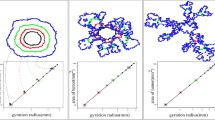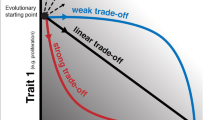Abstract
A malignant tumor is a dynamic amalgamation of various cell phenotypes, both cancerous (parenchyma) and healthy (stroma). These diverse cells compete over resources as well as cooperate to maintain tumor viability. Therefore, tumors are both an ecological community and an integrated tissue. An understanding of how natural selection operates in this unique ecological context should expose unappreciated vulnerabilities shared by all cancers. In this study I address natural selection’s role in tumor evolution by developing and exploring a mathematical model of a heterogenous primary neoplasm. The model is a system of nonlinear ordinary differential equations tracking the mass of up to two different parenchyma cell types, the mass of vascular endothelial cells from which new tumor blood vessels are built and the total length of tumor microvessels. Results predict the possibility of a hypertumor—a focus of aggressively reproducing parenchyma cells that invade and destroy part or all of the tumor, perhaps before it becomes a clinical entity. If this phenomenon occurs, then we should see examples of tumors that develop an aggressive histology but are paradoxically prone to extinction. Neuroblastoma, a common childhood cancer, may sometimes fit this pattern. In addition, this model suggests that parenchyma cell diversity can be maintained by a tissue-like integration of cells specialized to provide different services.
Similar content being viewed by others
References
Bertuzzi, A., M. Faretta, A. Gandolfi, C. Sinisgalli, G. Starace, G. Valoti and P. Ubezio (2002). Kinetic heterogeneity of an experimental tumour revealed by BrdUrd incorporation and mathematical modeling. Bull. Math. Biol. 64, 355–384.
Cahill, D. P., K. W. Kinzler, B. Vogelstein and C. Lengauer (1999). Genetic instability and Darwinian selection in tumors. Trends Cell Biol. 9, M57–M60.
Carmeliet, P. and R. K. Jain (2000). Angiogenesis in cancer and other diseases. Nature 407, 249–257.
Chang, C. and Z. Werb (2001). The many faces of metalloproteases: cell growth, invasion, angiogenesis and metastasis. Trends Cell Biol. 11, S37–S43.
Cheng, K. C. and L. A. Loeb (1997). Genomic stability and instability: a working paradigm. Curr. Top. Microbiol. Immunol. 221, 5–18.
Colombo, M. P., L. Lombardi, C. Melani, M. Parenza, C. Baroni, L. Ruco and A. Stoppacciaro (1996). Hypoxic tumor cell death and modulation of endothelial adhesion molecules in the regression of granulocyte colony-stimulating factor-transduced tumors. Am. J. Pathol. 148, 473–483.
Cotran, R. S., V. Kumar and T. Collins (1999). Pathologic Basis of Disease, 6th edn, Philadelphia: W.B. Saunders.
Evan, G. I. and K. H. Vousden (2001). Proliferation, cell cycle and apoptosis in cancer. Nature 411, 342–347.
Folkman, J., P. Hahnfeldt and L. Hlatky (2000). Cancer: looking outside the genome. Nat. Rev. Mol. Cell Biol. 1, 76–79.
Gammack, D., H. M. Byrne and C. E. Lewis (2001). Estimating the selective advantage of mutant p53 tumour cells to repeated rounds of hypoxia. Bull. Math. Biol. 63, 135–166.
Ganong, W. F. (1999). Review of Medical Physiology, 19th edn, Stamford, CT: Appleton and Lange.
Graber, T. G., C. Osmanian, T. Jacks, D. E. Housman, C. J. Koch, S. W. Lowe and A. J. Giaccia (1996). Hypoxia-mediated selection of cells with diminished apoptotic potential in solid tumours. Nature 379, 88–91.
Hannahan, D. and R. A. Weinberg (2000). The hallmarks of cancer. Cell 100, 57–70.
Holash, J., P. C. Maisonpierre, D. Compton, P. Boland, C. R. Alexander, D. Zagzag, G. D. Yancopolous and S. J. Weigand (1998). Vessel cooperation, regression and growth in tumors mediated by angiopoietins and VEGF. Science 221, 1994–1998.
Horn, L., W. S. Krajewski, P. K. Paul, M. J. Song and M. J. Sydor (1988). Computerized 3-D reconstruction of small blood vessels from high voltage electron-micrographs of thick serial cross sections, in Vascular Endothelium in Health and Disease, S. Chien (Ed.), New York: Plenum Press, pp. 35–42.
Jain, R. K., N. Safabakhsh, A. Sckell, Y. Chen, P. Jiang, L. Benjamin, F. Yuan and E. Keshet (1998). Endothelial cell death, angiogenesis, and microvascular function after castration in an androgen-dependent tumor: role of vascular endothelial growth factor. Proc. Natl. Acad. Sci. 95, 10820–10825.
Kitanaka, C., K. Kato, I. R. Sakurada, A. Tomiyama et al. (2002). Increased Ras expression and caspase-independent neuroblasotoma cell death: possible mechanism of spontaneous regression. J. Natl. Cancer. Inst. 94, 319–321.
Kraggerud, S. M., J. A. Sandvik and E. O. Pattersen (1995). Regulation of protein synthesis in human cells exposed to extreme hypoxia. Anticancer Res. 15, 683–686.
Lobov, I. B., P. C. Brooks and R. A. Lang (2002). Angiopoietin-2 displays VEGF-dependent modulation of capillary structure and endothelial cell survival in vivo. Proc. Natl. Acad. Sci. 99, 11205–11210.
Loeb, L. A. (1996). Many mutations in cancer. Cancer Surv. 28, 329–342.
Mabry, M., B. Nelkin and S. Baylin (1996). Evolutionary model of lung cancer, in Lung Cancer: Principles and Practice, H. I. Pass, J. B. Mitchell, D. H. Johnson and A. T. Turrisi (Eds), Philadelphia, PA: Lippencott-Raven, pp. 133–142.
Miller, D. L., J. A. Dibbens, A. Damert, W. Risau, M. A. Vadas and G. J. Goodall (1998). The vascular endothelial growth factor mRNA contains an internal ribosome entry site. FEBS Lett. 434, 417–420.
Nagy, J. D. (1996). Evolutionarily attracting dispersal strategies in vertebrate metapopulations, PhD dissertation, Arizona State University, Tempe, AZ.
Neufeld, G., T. Cohen, S. Gengrinovitch and Z. Poltorak (1999). Vascular endothelial growth factor (VEGF) and its receptors. FASEB 13, 9–22.
Qumsiyeh, M. B. and P. Li (2001). Molecular biology of cancer: cytogenetics, in Cancer: Principles and Practice of Oncology, V. T. DeVita Jr., S. Hellman and S. A. Rosenberg (Eds), Philadelphia, PA: Lipincott, Williams and Wilkens.
Rowley, D. R. (1998). What might a stromal responsemean to prostate cancer progression? Cancer Metastasis Rev. 17, 411–419.
Schofield, D. and R. S. Cotran (1999). Diseases of infancy and childhood, in Pathologic Basis of Disease, 6th edn, R. S. Cotran, V. Kumar and T. Collins (Eds), Philadelphia, PA: W.B. Saunders, pp. 459–491.
Stein, I., M. Neeman, D. Shweik, A. Itin and E. Keshet (1995). Stabilization of vascular endothelial growth factor mRNA by hypoxia and hypoglycemia and coregulation with other ischemia-induced genes. Mol. Cell Biol. 15, 5363–5368.
Terada, T., Y. Okada and Y. Nakanuma (1996). Expression of immunoreactive matrix metalloproteinases and tissue inhibitors of matrix metalloproteinases in human normal livers and primary liver tumors. Hepatology 23, 1341–1344.
Testa, J. R. (1996). Chromosome alterations in human lung cancer, in Lung Cancer: Principles and Practice, H. I. Pass, J. B. Mitchell, D. H. Johnson and A. T. Turrisi (Eds), Philadelphia, PA: Lippencott-Raven, pp. 55–71.
Thompson, K. E. and J. A. Royds (1999). Hypoxia and reoxygenation: a pressure for mutant p53 cell selection and tumour progression. Bull. Math. Biol. 61, 759–778.
Tuxhorn, J. A., G. E. Ayala and D. R. Rowley (2001). Reactive stroma in prostate cancer progression. J. Urol. 166, 2472–2483.
Vajkoczy, P., M. Farhadi, A. Gaumann, R. Heidenreich, R. Erber, A. Wunder, J. C. Tonn, M. D. Menger and G. Breier (2002). Microtumor growth initiates angiogenic sprouting with simultaneous expresseion of VEGF, VEGF receptor-2, and angiopoietin-2. J. Clin. Invest. 109, 777–785.
Weibel, E. R. (1984). The Pathway for Oxygen: Structure and Function of the Mammalian Respiratory System, Cambridge: Harvard University Press, p. 425.
Weinert, N. (1997). The multiple roles of tumor stroma. Virchows Arch. 430, 433–443.
Yancopoulos, G. D., S. Davis, N. W. Gale, J. S. Rudge, S. J. Wiegand and J. Holash (2000). Vascular-specific growth factors and blood vessel formation. Nature 407, 242–248.
Author information
Authors and Affiliations
Rights and permissions
About this article
Cite this article
Nagy, J.D. Competition and natural selection in a mathematical model of cancer. Bull. Math. Biol. 66, 663–687 (2004). https://doi.org/10.1016/j.bulm.2003.10.001
Received:
Accepted:
Issue Date:
DOI: https://doi.org/10.1016/j.bulm.2003.10.001




